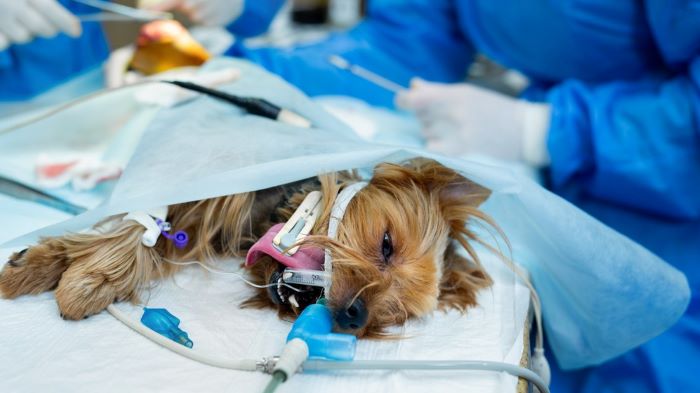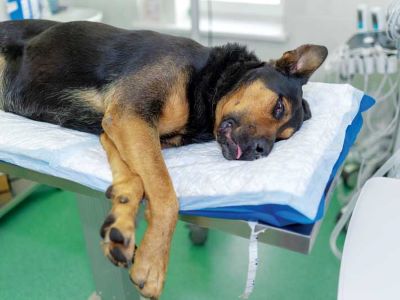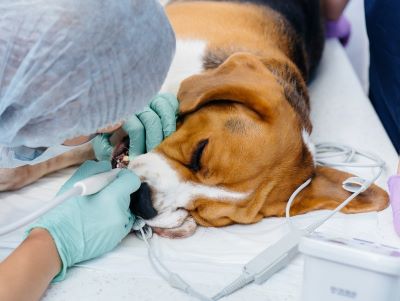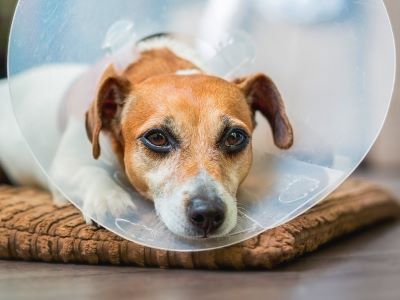If you have a dog that needs surgery or a dental procedure, you may be wondering what anesthesia is and “How long does anesthesia lasts in dogs?”
- Anesthesia is a medical term that means the loss of sensation or awareness, either partially or completely.
- Anesthesia helps dogs cope with painful or stressful procedures.
- It can be of different types and durations, depending on the situation and the dog.
- Each type has its pros and cons and affects dogs in different ways.

In general, anesthesia lasts for a few hours in dogs, but it can vary depending on several factors.
Such as the type and dose of anesthesia, the size and age of your dog, the procedure performed, and the dog’s health condition.
In this article, we will explain how these factors affect the duration of anesthesia in dogs, how to recognize the signs and symptoms of anesthesia recovery in dogs, and when to contact your veterinarian if you have any concerns.
Contents
How Long Can Anesthesia Last in Dogs?
If your dog needs to undergo a procedure that requires anesthesia, you may be wondering how long does anesthesia lasts in dogs and recover from the effects of the drugs.

Anesthesia lasts between 24 and 48 hours in the majority of dogs. But there are many factors that can influence how long anesthesia lasts in dogs. Some of these factors are:
Type and Dose of Anesthesia
Different types of anesthesia have different durations and effects on dogs. For example, general anesthesia, which puts your dog into a deep sleep, usually lasts longer than local anesthesia, which numbs a specific area of the body.
Sedation, which relaxes your dog without making them unconscious, may wear off faster than general anesthesia.
The dose of anesthesia also affects how long it lasts, as higher doses may take longer to metabolize and eliminate from your dog’s body.[1]
Size and Age of the Dog
The size and age of your dog can also affect how long anesthesia lasts. Smaller dogs may be more sensitive to anesthesia and may need lower doses or shorter durations than larger dogs.
Older dogs may have slower metabolism and elimination of anesthesia and may take longer to recover than younger dogs. Toy breeds and giant breeds may have higher risks of anesthetic complications due to their size.
Duration of The Procedure Performed
The type and duration of the procedure performed can also influence how long anesthesia lasts in dogs.
Some procedures may require longer or deeper anesthesia than others, depending on the complexity and invasiveness of the procedure.

For example, a dental cleaning may require less anesthesia than a major surgery. The length of the procedure also affects how long your dog is exposed to anesthesia and how long it takes for them to wake up.
Dog’s Health Condition
The length of time that a dog is under anesthesia depends on their health. Pre-existing medical disorders in dogs.
Such as diabetes, renal, liver, or heart disease, may impede their metabolism and anesthetic removal, making recovery time longer than in healthy dogs.
Dogs with respiratory issues, such as brachycephalic breeds, may be more susceptible to difficulties involving the airways during and after anesthesia.
Tips for Preparing Your Dog for Anesthesia
To help your dog have a safe and smooth anesthetic experience, you should follow your veterinarian’s instructions and recommendations regarding pre-anesthetic preparation and post-anesthetic care. Some general tips are:
- Fasting your dog for at least 12 hours before the procedure to prevent vomiting and aspiration.
- Informing your veterinarian about any medications or supplements your dog is taking, as some of them may interact with anesthesia or increase bleeding risk.[2]
- Bringing your dog’s favorite blanket or toy to comfort them before and after the procedure.

- Keeping your dog calm and quiet before the procedure to reduce stress and anxiety.
- Monitoring your dog closely after the procedure for any signs of pain, discomfort, or complications.
- Following your veterinarian’s instructions regarding feeding, watering, medication administration, wound care, activity restriction, and follow-up visits.
Signs and Symptoms of Anesthesia Recovery in Dogs
After your dog returns home from a procedure that required anesthesia, you should monitor his vital signs, behavior, and comfort level during and after anesthesia recovery.[3]
This will help you identify any signs of pain, discomfort, or complications that may require veterinary attention.
Some of the common signs and symptoms of anesthesia recovery in dogs are:
Normal Anesthesia Recovery Behaviors

- After anesthesia, the majority of dogs will be tired, foggy, or unsteady for 12 to 24 hours.
- While the effects of the medications may not totally wear off for some time, this is anticipated and usual.
- Also, you could notice your dog’s weird look, poor appetite, or dry mouth.
- These side effects are often short and minor, and they should go away in a day or two.
- Your dog should be kept in a calm, warm environment, away from other animals and kids, and allowed to rest until he feels more awake and active.
- Also, you should adhere to your vet’s recommendations for post-procedure feeding, watering, and medication delivery.
When to Contact Your Veterinarian
It is very important to follow your veterinarian’s instructions and recommendations regarding anesthesia and post-operative care for your dog.
This will help ensure your dog’s safety and comfort, and prevent any potential risks and complications of anesthesia.
Some of the possible risks and complications of anesthesia in dogs are:
a). Abnormal anesthesia recovery signs: While some mild and temporary side effects of anesthesia are normal and expected, such as sleepiness, nausea, or dry mouth.[4]
Some signs and symptoms may indicate a serious problem that requires immediate veterinary attention.

You should contact your veterinarian if you notice any of the following abnormal signs in your dog after anesthesia.
- Difficulty breathing or noisy breathing
- Excessive bleeding or discharge from the surgical site
- Persistent vomiting or diarrhea
- Severe pain or discomfort that does not improve with pain medication
- Pale or blue gums
- Abnormal heart rate or rhythm
- Seizures or tremors
- Loss of consciousness or collapse
- Swelling or redness at the injection site
- Signs of an allergic reaction, such as hives, itching, swelling, or difficulty breathing
If you notice any of these signs, do not wait for them to get worse. Call your veterinarian immediately or take your dog to the nearest emergency clinic.
Your dog may need additional treatment or medication to address the problem and prevent further complications.
FAQs
How long does it take for dog to walk after anesthesia?
It depends on the type and dose of anesthesia. Some dogs may be able to walk shortly after waking up from anesthesia, while others may need more time to regain their balance and coordination.
In general, most dogs will be able to walk within 12 to 24 hours after anesthesia.
However, they may still be wobbly, groggy, or disoriented, so you should keep them on a leash and supervise them closely until they are fully recovered.
What are the after effects of anesthesia in dogs?
Some of the common after effects of anesthesia in dogs are: Sleepiness, grogginess, or wobbliness, nausea, vomiting, or diarrhea, dry mouth or dehydration, low appetite or difficulty eating, mild pain or discomfort, goofy facial expression or behavior.
Do dogs change after anesthesia?
Most dogs will not change permanently after anesthesia, but they may act differently temporarily due to the effects of the drugs.
What helps a dog after anesthesia?
Keep your dog in a quiet and warm area, away from other pets and children, let your dog rest until he feels more alert and energetic.
Follow your veterinarian’s instructions regarding feeding, watering, and medication administration, monitor your dog’s vital signs, behavior, and comfort level.
Contact your veterinarian if you notice any abnormal or concerning signs or symptoms.
Conclusion
In this article, you have learned about anesthesia in dogs: what it is, how it affects them, and how long does anesthesia lasts in dogs. You have also learned how to care for your dog after anesthesia and what signs to look for in case of trouble.
The important lesson learned is that,
- Anesthesia lasts in dogs about 12 – 24 hours, it varies based on a variety of conditions.
- For canines undergoing medical treatments, anesthesia is typically beneficial and safe, but it also has significant hazards.
- Your dog will be properly monitored and readied for anesthesia by your veterinarian.
- Following your veterinarian’s recommendations and showering your dog with affection and comfort will also benefit your pet.
We hope this article has been informative and reassuring for you. If you have any questions or stories about anesthesia in dogs, please share them with us in the comments below!
References:
- Anastasio, A. (2021). Dog Anesthesia: What Every Dog Owner Should Know. American Kennel Club.- AKC
- Anesthesia for Dogs | VCA Animal Hospitals. (n.d.). Retrieved June 20, 2023, from – VCA Hospitals
- Hernández-Ávalos, I., Flores-Gasca, E., Mota-Rojas, D., Casas-Alvarado, A., Miranda-Cortés, A., & Domínguez-Oliva, A. (2021). Neurobiology of anesthetic-surgical stress and induced behavioral changes in dogs and cats: A review. Vet World, 14(2), 393–404. – Veterinary World
- Common and Rare Side Effects for Anesthesia S/I-60 (propofol) intravenous. (n.d.). Retrieved June 20, 2023, from – WebMD

Julia is a Board Certified Veterinary Nutritionist, practicing veterinarian in a non-profit animal hospital and feline sanctuary located in Rochester, NY. She is also a full-time veterinary advisor at DogLikesBest. She focuses on writing healthcare-related topics including dog foods, treats, veterinary diets, food for specific healthcare features, etc. Moreover, any article on DogNeedsBest that has to concern feline health in any way, goes under her scrutiny before being published.

